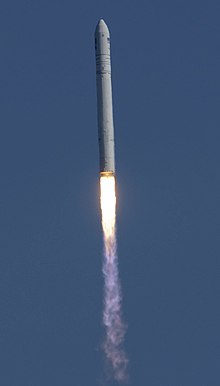 Launch of an Antares 230 | |
| Function | Medium-lift launch vehicle |
|---|---|
| Manufacturer |
|
| Country of origin | United States |
| Project cost | US$472 million until 2012[1] |
| Cost per launch | US$80−85 million[2] |
| Size | |
| Height | |
| Diameter | 3.9 m (13 ft)[6][5] |
| Mass | |
| Stages | 2 to 3[6] |
| Capacity | |
| Payload to LEO | |
| Mass | 8,000 kg (18,000 lb)[7] |
| Associated rockets | |
| Comparable | Delta II, Atlas III |
| Launch history | |
| Status |
|
| Launch sites | MARS, LP-0A |
| Total launches | 18 (110: 2, 120: 2, 130: 1, 230: 5, 230+: 8) |
| Success(es) | 17 (110: 2, 120: 2, 130: 0, 230: 5, 230+: 8) |
| Failure(s) | 1 (130: 1) |
| First flight |
|
| Last flight |
|
| Type of passengers/cargo | Cygnus |
| First stage (Antares 100) | |
| Empty mass | 18,700 kg (41,200 lb)[4] |
| Gross mass | 260,700 kg (574,700 lb)[4] |
| Powered by | 2 × NK-33 (AJ26-62)[8] |
| Maximum thrust | 3,265 kN (734,000 lbf)[8] |
| Specific impulse | SL: 297 s (2.91 km/s) vac: 331 s (3.25 km/s)[4] |
| Burn time | 235 seconds[4] |
| Propellant | RP-1 / LOX[8] |
| First stage (Antares 200) | |
| Empty mass | 20,600 kg (45,400 lb)[5] |
| Gross mass | 262,600 kg (578,900 lb)[5] |
| Powered by | 2 × RD-181[5] |
| Maximum thrust | 3,844 kN (864,000 lbf)[5] |
| Specific impulse | SL: 311.9 s (3.06 km/s) vac: 339.2 s (3.33 km/s)[5] |
| Burn time | 215 seconds[5] |
| Propellant | RP-1 / LOX |
| First stage (Antares 300) | |
| Powered by | 7 × Miranda[9] |
| Propellant | RP-1 / LOX |
| Second stage – Castor 30A/B/XL | |
| Gross mass |
|
| Propellant mass |
|
| Maximum thrust |
|
| Burn time | |
| Propellant | TP-H8299 / Al / AP[11] |
| Part of a series on |
| Private spaceflight |
|---|
 |
| Active companies |
| Active vehicles |
| Contracts and programs |
| Related |
Antares (/ænˈtɑːriːz/), known during early development as Taurus II, is an American expendable medium-lift launch vehicle developed and built by Orbital Sciences Corporation (later Orbital ATK and Northrop Grumman) with financial support from NASA under the Commercial Orbital Transportation Services (COTS) program awarded in February 2008, alongside the company's automated cargo spacecraft, Cygnus. Like other launch vehicles developed by Orbital, Antares leveraged lower-cost, off-the-shelf parts and designs.
The first stage is liquid fueled, burning RP-1 (kerosene) and liquid oxygen (LOX). Due to Orbital's limited experience with large liquid stages, the construction was subcontracted to the Ukrainian companies Pivdenne and Pivdenmash. Initially, the Antares 100 series used refurbished NK-33 engines, remnants of the Soviet N1 moon rocket. However, after a catastrophic explosion, the Antares 200 series transitioned to newly built Russian RD-191 engines. Following Russia's invasion of Ukraine, Northrop Grumman announced plans for the Antares 300, featuring a new first stage developed in partnership with Firefly Aerospace. The new first stage, similar to Firefly's MLV launch vehicle, will incorporate composite structures and seven Miranda engines, increasing Antares' payload capacity.
The second stage is a Castor 30-series solid-fuel rocket, derived from the Castor 120 solid motor used in Orbital's Minotaur-C (the original Taurus I), and itself based on a Peacekeeper ICBM first stage. While an optional third stage is offered, it has never been used due to the Cygnus spacecraft's integrated service module.
Antares made its maiden flight on April 21, 2013, launching the Antares A-ONE mission from LP-0A at the Mid-Atlantic Regional Spaceport (MARS) with a Cygnus mass simulator. Later that year, on September 18, the rocket successfully launched Orb-D1, the first Cygnus mission to rendezvous with the International Space Station (ISS). Following the successful completion of these two COTS demonstration missions, Antares and Cygnus have been awarded two Commercial Resupply Services contracts, encompassing a total of 25 missions to the ISS.
The COTS program also funded the development of SpaceX's Dragon spacecraft and Falcon 9 rocket, aiming to stimulate the commercial space industry by creating two medium-lift launch vehicles. While SpaceX's Falcon 9 has achieved significant commercial success, Antares has not. To date, NASA remains Antares' sole customer, and Cygnus its only payload.
- ^ Cite error: The named reference
fglobal20120430was invoked but never defined (see the help page). - ^ "Surplus Missile Motors: Sale Price Drives Potential Effects on DOD and Commercial Launch Providers" (PDF). U.S. Government Accountability Office. August 2017. p. 30. GAO-17-609. Archived (PDF) from the original on April 20, 2023.
- ^ Cite error: The named reference
slr20110514was invoked but never defined (see the help page). - ^ a b c d e f g Cite error: The named reference
sf101-antares100was invoked but never defined (see the help page). - ^ a b c d e f g h i j Cite error: The named reference
sf101-antares200was invoked but never defined (see the help page). - ^ a b Cite error: The named reference
os201112bwas invoked but never defined (see the help page). - ^ Cite error: The named reference
orbital-fs2017was invoked but never defined (see the help page). - ^ a b c Cite error: The named reference
os201112awas invoked but never defined (see the help page). - ^ Cite error: The named reference
spacenewsfireflywas invoked but never defined (see the help page). - ^ "Antares". Yuzhnoye Design Bureau. Archived from the original on November 25, 2017. Retrieved November 19, 2017. Alt URL Archived November 29, 2020, at the Wayback Machine
- ^ Cite error: The named reference
NSF-launchwas invoked but never defined (see the help page).